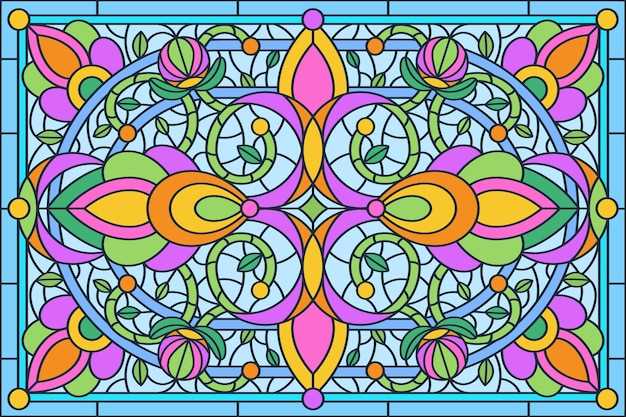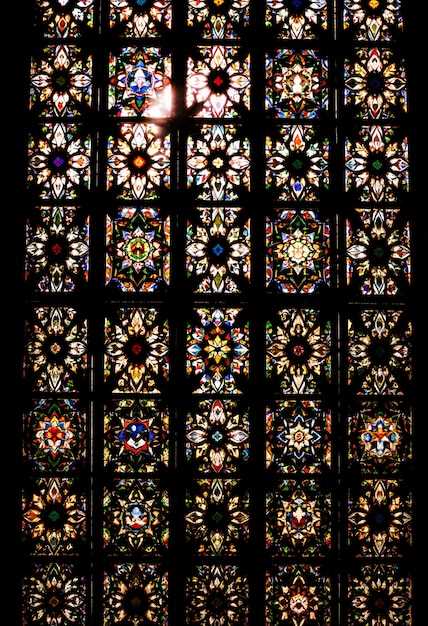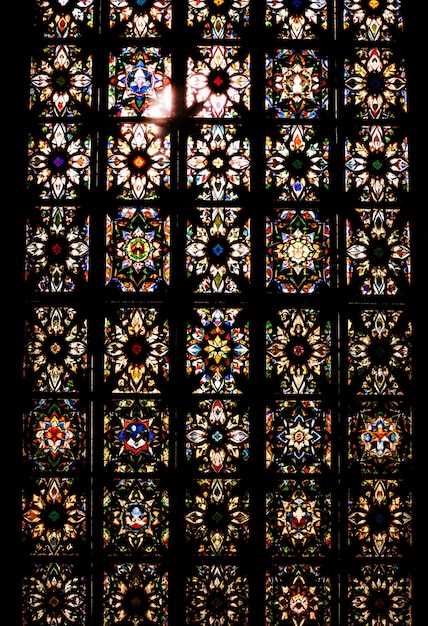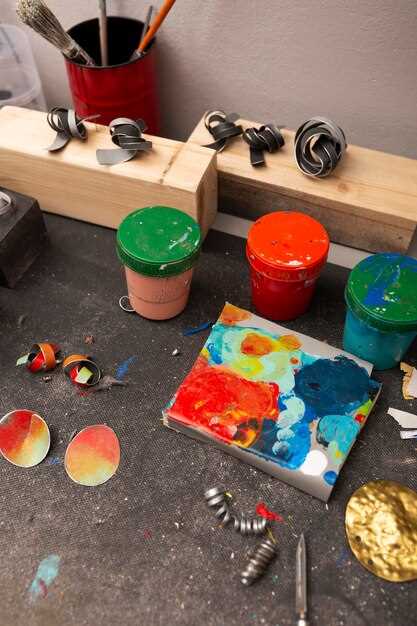Artistic expressions through colorful light manifestations have captured hearts for centuries. These vibrant creations transform ordinary spaces into realms of wonder. They illuminate not just buildings, but also the human spirit. Every piece tells stories, carries emotions, and reflects cultures. Exploring these masterpieces reveals a captivating journey filled with techniques and traditions.
Unique approaches and innovations emerge throughout different eras. Various cultures have contributed to this captivating form of artistry. From medieval cathedrals to modern installations, the evolution is astonishing. Adopting diverse methods provides artists with endless possibilities for expression and creativity.
Each colorful panel captivates those who gaze upon it. The interplay of light and color evokes profound feelings. Crafting these masterpieces requires skill, patience, and a deep understanding of materials. Many artisans invest countless hours honing their craft, ensuring perfection in every detail.
The world of chromatic creations offers endless inspiration. These radiant artworks influence architecture, interior design, and even contemporary art. Finding motivation in historical techniques can spark new ideas and innovations. As traditions blend with modern designs, fresh narratives emerge in luminous forms.
Embarking on this journey opens doors to rich traditions and brilliant concepts. From its ancient origins to present-day masterpieces, this art form persists in captivating imaginations everywhere. Understanding its evolution reveals the passion and dedication behind it, allowing all to appreciate its timeless beauty.
The Ultimate Guide to Stained Glass Windows

Exploring the enchanting world of colorful panes reveals a blend of artistry and craftsmanship. Each piece tells a story, capturing light in mesmerizing ways. From ancient churches to modern installations, these luminous setups speak to the imagination. They enhance architectural beauty, enriching spaces with their vibrant hues and intricate designs.
Craftsmanship involved in creating these masterpieces is both meticulous and fascinating. Techniques range from traditional methods to contemporary innovations. Artists harness various materials and inspirations, resulting in unique compositions. These creations are not just decorative; they serve as reflections of cultural heritage.
- Origins can be traced back to early civilizations.
- Religious significance often plays a central role.
- Designs evolve over time, influenced by styles and movements.
- Modern examples show a shift towards abstract interpretations.
Whether you marvel at gothic arches or minimalist designs, each one reveals a deep connection to its environment that resonates with viewers, often eliciting a sense of wonder and contemplation.
- Preparation of materials is crucial for achieving desired effects.
- Assembly techniques vary significantly from artist to artist.
- Final installations consider light dynamics to maximize impact.
Innovation in this realm continues to thrive, with artists experimenting with different techniques and media, ensuring that this timeless art remains relevant and captivating for generations to come.
Exploring the History and Artistry

Artistry found in colorful creations dates back centuries. Many cultures embraced this craft, each adding unique elements. Vibrant hues and intricate designs captivated viewers hearts. Techniques evolved, reflecting the changing tastes and beliefs of society.
From ancient churches to modern installations, this art form tells stories. It serves as a bridge connecting generations to their heritage. Skillful artisans not only shaped materials but also transformed spaces into realms of wonder.
Noteworthy is how tradition and innovation intertwine throughout various epochs. Techniques were meticulously refined over time, giving rise to mesmerizing masterpieces.
From the medieval period to contemporary times, these creations continue to inspire and challenge artists. Each piece captures a unique narrative, combining both sacred and secular themes.
The dialogue between light and pigment creates an enchanting atmosphere. This interaction enriches spaces, offering moments of reflection and awe. As we delve deeper into this fascinating craft, we uncover layers of meaning waiting to be explored.
An Overview of Stained Glass Origins
Exploring the beginnings of colorful panes reveals a rich cultural tapestry. Originating from ancient practices, these vibrant artworks have fascinated generations. They serve not only as decoration but also as a means of storytelling. Craftsmanship and artistry intertwine in a way that captivates viewers.
Early examples can be traced back to the Roman Empire. These handcrafted pieces utilized simple techniques, primarily focused on color and shape. Over time, innovations emerged, elevating this art form to new heights.
In medieval Europe, churches became the primary venues for this expressive medium, as skilled artisans created intricate narratives that depicted religious themes and biblical stories. The careful selection of hues and skilled assembly transformed mundane spaces into ethereal realms, inviting worshippers to immerse themselves in a spectacle of spirituality.
As centuries progressed, numerous styles evolved alongside changing cultural contexts. From Gothic to Renaissance, each period influenced production methods and design. Artisans developed more advanced techniques, incorporating new materials to enhance vibrancy and durability, reflecting the society’s values and beliefs through an ever-evolving lens.
Today, these masterpieces continue to inspire admiration and creativity, reminding us of their enduring legacy. The journey of these luminous creations illustrates a deep connection to humanity’s artistic expression across time and space.
Significant Historical Periods
Examining key eras provides valuable insight into artistic evolution. Each period reveals distinct styles and cultural influences. Changes in technique reflect broader societal shifts. Artistic expression continued to adapt and innovate, driven by various factors.
During the Middle Ages, religious themes predominated. Artists often created works to inspire devotion. Cathedrals became centers of spirituality and artistry. These creations demonstrated remarkable technical skill, using vibrant colors to convey narratives.
The Renaissance marked a profound transformation in artistic approaches. Not only did it celebrate humanism, but it also embraced classical elements. Artists explored perspective and naturalism, which influenced decorative practices significantly. This era’s works conveyed depth, emotion, and storytelling with unparalleled sophistication.
In the 19th century, there was a revival of interest in medieval techniques. Artists sought to reconnect with historical craftsmanship. Movements like Arts and Crafts emphasized handmade artistry over industrial production. Simultaneously, innovations in glass production expanded the possibilities for design.
Modern times have witnessed a fusion of traditional and contemporary styles. Artists blend old techniques with innovative ideas, pushing boundaries. This combination allows for unique expressions that reflect current values. It creates an intriguing dialogue between past and present, ensuring the legacy continues.
Influences of Religion and Culture
Religion and culture weave intricate patterns into the narrative of artistic expression. Different eras and societies have left their imprint on various art forms. Spiritual beliefs often shape the themes and motifs found within artistic creations. In many instances, cultural heritage plays a significant role in determining aesthetic choices. Each piece tells a story that resonates with collective identities.
Faith and spirituality have long guided creative expression, influencing color palettes and design approaches. From ancient civilizations to modern times, religious symbols often emerge, indicating deeper meanings. These elements reflect community values, demonstrating the intertwining of life, belief, and creativity. Whether it be the vibrant hues of devotion or the serene depictions of peace, each creation carries a message.
Religious narratives frequently serve as inspiration for artistic projects, showcasing both historical events and moral lessons. Artists channel their devotion into their work, capturing the awe of divinity. Through centuries, cultural shifts prompted transformations in style and technique, reflecting contemporary thoughts and societal concerns, yet somehow maintaining a connection to timeless traditions.
Across continents, diverse faiths provide a rich source of symbolism and imagery. This blend of influences creates a kaleidoscope of interpretations that resonate with viewers. The sacredness attributed to certain motifs often conveys a profound respect for spirituality. In many cultures, the interplay between beliefs and artistry becomes a reflection of human experiences and aspirations.
Key Artists and Their Contributions
Numerous creators have left an indelible mark on this art form. Each has contributed unique styles and techniques. Their innovations shaped not only the aesthetic but also the emotional resonance of every piece. From ancient times to contemporary expressions, the evolution is remarkable.
One cannot overlook the influence of medieval artisans. They epitomized spiritual storytelling through vivid hues and intricate designs. Some contemporary artists continue to draw inspiration from these historical roots, merging old traditions with modern visions.
Louis Comfort Tiffany revolutionized the field with his unique approach in the late 19th century. His craftsmanship showcased how light could transform everyday materials into extraordinary experiences. By employing copper foil instead of traditional lead came, he unlocked new possibilities in texture and color.
Mark Chagall, a 20th-century icon, infused his creations with rich symbolism and dreamlike imagery. His installations introduced a narrative quality rarely seen before, intertwining personal and communal stories. Chagall’s pieces often appeared in synagogues, emphasizing spiritual connections amid vibrant colors.
Frank Lloyd Wright also made significant contributions, especially through architectural integration. His designs seamlessly incorporated art into structures, allowing windows to play a vital role in overall aesthetics. The harmony between space and art became a signature of his style.
Ultimately, these pioneers and many others shaped the landscape, inspiring new generations of artists and enthusiasts alike. Their legacies endure, reminding us of the profound impact that creativity can have on both individual experience and communal heritage.
Techniques and Design Ideas
Creating stunning works requires a blend of skill and imagination. Artists experiment with various processes to achieve unique effects. Every piece tells a story, reflecting personal expression and cultural heritage. There are countless approaches, all varying in execution and visual impact.
Techniques can range from traditional methods to modern innovations. One popular approach is leading, where pieces are joined with strips of metal. Another option is copper foiling, offering more flexibility in design. Each method presents different challenges and rewards.
Color plays a crucial role in crafting compelling visuals. Artists often layer hues to produce depth and richness, transforming simple patterns into captivating masterpieces. The interplay of light enhances these creations, casting mesmerizing shadows and reflections.
| Technique | Description | Best For |
|---|---|---|
| Leading | Joining pieces with strips of metal | Structured designs |
| Copper Foiling | Using adhesive copper tape for edges | Intricate shapes |
| Etching | Creating patterns by removing surface layers | Detailed textures |
| Fused Techniques | Melting pieces together to form solid bonds | Bold interpretations |
| Painting | Adding designs with special glass paints | Personalized artwork |
Inspiration can come from anywhere, whether nature, architecture, or everyday life. Many artists find joy in their surroundings, letting the world around them guide their creativity. Themes can range from the abstract to the representational, allowing for endless interpretations. Every choice–from color to technique–can alter the overall message.
Exploring different styles can lead to exciting discoveries. Minimalist designs often convey peace and tranquility. Conversely, intricate works may evoke wonder and admiration. The key lies in understanding one’s vision and translating it into a tangible form. As techniques evolve, so too does the potential for new expressions, making this medium a vibrant field for experimentation.
Fundamental Techniques in Glasswork
Creating mesmerizing art from translucent materials involves a variety of essential methods. Each technique contributes to the final masterpiece, showcasing both skill and creativity. They transform simple sheets into objects of beauty. Mastery of these processes is crucial for artists striving for excellence.
Cutting serves as a foundational skill in this craft. Precision is vital. Artists use specialized tools to score and snap pieces with accuracy. A well-executed cut can determine the flow of the entire project.
Fusing is another captivating method. By heating glass to its melting point, different colors can merge beautifully. This creates unique patterns and textures. Fusing allows for innovative designs, expanding the possibilities significantly.
Layering techniques add depth and dimension to each creation. By stacking sheets of varying colors, artisans achieve incredible visual effects. This approach invites exploration into light and shadow, enhancing the overall aesthetic.
Soldering bonds components together, ensuring stability and durability. A steady hand is essential for clean joints. This technique can alter the piece’s appearance and structural integrity, so attention to detail is paramount.
Many artists employ etching and painting to personalize their work. These methods decorate surfaces, providing rich details and intricate designs. Utilizing various chemicals or pigments adds character, defining the unique essence of each artwork.
Incorporating these multiple techniques ultimately results in stunning creations that resonate deeply with viewers. The journey from concept to completion is skill-intensive and deeply rewarding. Embracing each fundamental approach enhances the mastery of this picturesque craft.
Custom Glass Panels: Crafting Unique Designs
Creating personalized panels can transform any space into a work of art. Each piece tells a story, reflecting individual preferences and artistic flair. They bring warmth and character to both modern and traditional settings. Unique elements catch the eye, sparking conversations. A harmonious blend of color, form, and function allows for endless creativity.
When designing custom panels, the possibilities are virtually limitless. Color choices play a crucial role in setting mood and tone. Different techniques can evoke distinct emotions and interpretations. Every detail, from texture to pattern, contributes to the overall impact. Engaging with skilled artisans ensures that visions come to life in remarkable ways.
Collaboration between clients and artists enhances the creative process, allowing for rich dialogue and brainstorming. Ideas can evolve rapidly, fueled by shared inspiration and mutual enthusiasm. Furthermore, incorporating personal symbols or meaningful motifs creates depth and significance within the piece.
Challenges may arise during design development, demanding patience and adaptability. Materials must be carefully selected to achieve desired effects. Techniques like layering and etching add complexity and intrigue. This intricate interplay between craftsmanship and artistic vision leads to stunning, one-of-a-kind results that are cherished for years to come.
Ultimately, custom panels invite opportunities for self-expression, turning everyday spaces into extraordinary experiences. They serve as a beautiful reminder of creativity’s power to enrich our lives. Whether a bold statement or subtle accent, each design holds the potential to inspire awe and admiration. Embrace the journey of crafting unique pieces that resonate deeply with personal style and storytelling.
Types of Glass Used in Artistry
Artistry involving colored material showcases a diverse range of variants. Each type has unique properties, influencing both appearance and function. Artists choose carefully based on design intentions and technical requirements. Variations in texture, transparency, and color enrich the creative possibilities.
- Float Glass: This is the basic glass used extensively for various purposes.
- Sheet Glass: Often thinner, available in numerous colors and patterns.
- Fused Glass: Created by melting pieces together at high temperatures.
- Blown Glass: Made by inflating molten material into shapes, offering curvatures.
Each type presents distinct characteristics that influence both technical execution and aesthetic outcome.
- Cathedral Glass: Highly transparent with a smooth finish, ideal for bright designs.
- Art Glass: This type includes unique colors with varied textures, perfect for abstract creations.
- Opalescent Glass: Features shimmering effects, allowing for beautiful light diffusion.
While different selections might cater to various artistic preferences, it’s crucial to understand how each material interacts with light and the surrounding environment, establishing mood and atmosphere in a setting.
In addition, some artists may opt for reclaimed or antique pieces, adding a layer of history and depth to their work. This not only promotes sustainability but also reflects a unique story through each installation. Understanding these alternatives enhances creativity within artistry.
Video:
How Are Stained Glass Windows Made?
How Are Stained Glass Windows Made? by History of Simple Things 884 views 8 hours ago 8 minutes, 19 seconds
Q&A:
What is the history behind stained glass windows?
Stained glass windows date back to ancient civilizations, with some of the earliest examples found in Roman and Byzantine architecture. These windows served a dual purpose: they allowed light to enter while also telling stories through vivid colors and intricate designs. During the Middle Ages, stained glass became prominent in cathedrals across Europe, depicting biblical scenes and saints to educate the largely illiterate population. This art form saw a decline during the Renaissance but experienced a revival in the 19th century with artists like Louis Comfort Tiffany, who experimented with new techniques and styles. Today, stained glass continues to evolve, blending traditional craftsmanship with contemporary design.
What techniques are commonly used in creating stained glass windows?
The creation of stained glass windows involves several techniques, each contributing to the final artwork. The most common technique is the use of lead came, where pieces of glass are joined together with lead strips, a method that allows for intricate designs. Another technique is copper foiling, which utilizes a thin strip of copper foil to connect glass pieces, giving artists more flexibility in shaping their designs. Additionally, glass can be painted or etched to add details, and different types of glass can be used to create texture and effects. Modern stained glass artists often combine these traditional techniques with contemporary innovation, resulting in unique and expressive pieces.
What are some design inspirations for stained glass windows?
Design inspirations for stained glass windows are vast and varied, often reflecting the artist’s personal vision or the architectural context in which the window will be placed. Nature is a significant source of inspiration, with floral patterns, landscapes, and animal motifs commonly featured. Historical themes, such as biblical narratives or local legends, continue to inspire designs, especially in religious settings. Moreover, contemporary artists often draw from abstract art and modern minimalism, creating vibrant and striking pieces that challenge traditional forms. Cultural influences, geometric patterns, and even music can shape designs, showcasing stained glass as a versatile medium for creative expression.
How do you maintain and care for stained glass windows?
Maintaining stained glass windows is essential to ensuring their longevity and beauty. Regular cleaning is crucial; however, it should be done with care. Use a soft, damp cloth and a mild soap solution to gently wipe down the glass, avoiding harsh chemicals that can damage the lead or paint. It’s best to avoid abrasive materials. Additionally, inspect the frames and lead came for any signs of deterioration or damage, as this can compromise the structure of the window. If any repairs are needed, it’s advisable to consult a professional conservator with experience in stained glass restoration to ensure the work is done correctly and preserves the integrity of the window.
Can stained glass windows be incorporated into modern architecture?
Absolutely! Stained glass windows can be beautifully integrated into modern architecture, adding a touch of artistry and color to contemporary designs. Architects and designers often utilize large expanses of glass to create light-filled spaces, and stained glass can offer both beauty and privacy. Modern stained glass can feature minimalist patterns or bold, abstract designs that complement the sleek lines of contemporary buildings. Moreover, innovative techniques allow for the creation of stained glass installations that serve as focal points or artistic dividers in open spaces. This fusion of tradition with modern aesthetics not only enriches architectural projects but also keeps the art of stained glass alive in today’s world.



